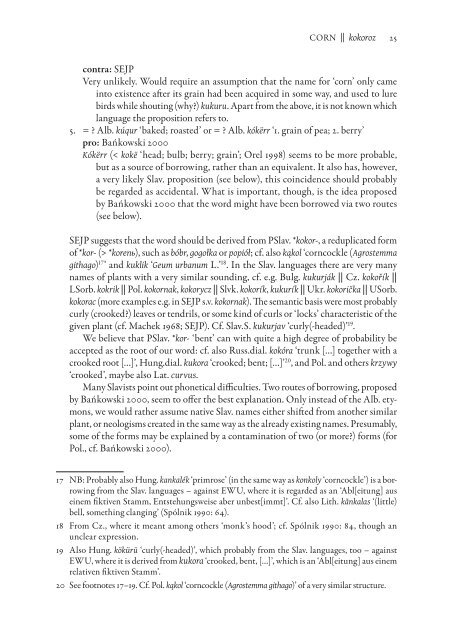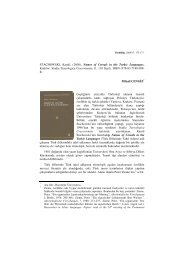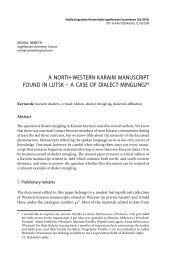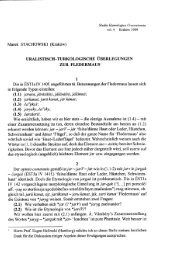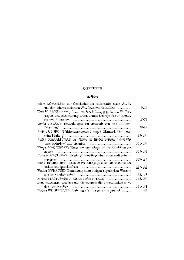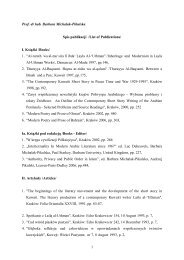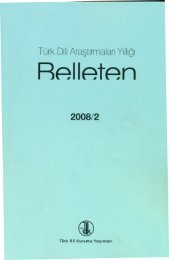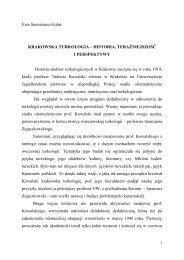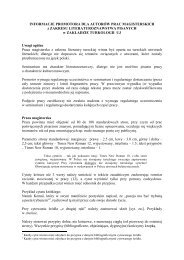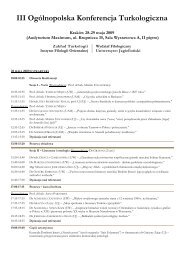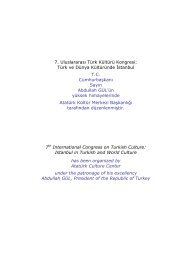Names of Cereals in the Turkic Languages - Wydział Filologiczny UJ
Names of Cereals in the Turkic Languages - Wydział Filologiczny UJ
Names of Cereals in the Turkic Languages - Wydział Filologiczny UJ
- No tags were found...
You also want an ePaper? Increase the reach of your titles
YUMPU automatically turns print PDFs into web optimized ePapers that Google loves.
Corn || kokoroz 25contra: SEJPVery unlikely. Would require an assumption that <strong>the</strong> name for ‘corn’ only came<strong>in</strong>to existence after its gra<strong>in</strong> had been acquired <strong>in</strong> some way, and used to lurebirds while shout<strong>in</strong>g (why?) kukuru. Apart from <strong>the</strong> above, it is not known whichlanguage <strong>the</strong> proposition refers to.5. = ? Alb. kúqur ‘baked; roasted’ or = ? Alb. kókërr ‘1. gra<strong>in</strong> <strong>of</strong> pea; 2. berry’pro: Bańkowski 2000Kókërr (< kokë ‘head; bulb; berry; gra<strong>in</strong>’; Orel 1998) seems to be more probable,but as a source <strong>of</strong> borrow<strong>in</strong>g, ra<strong>the</strong>r than an equivalent. It also has, however,a very likely Slav. proposition (see below), this co<strong>in</strong>cidence should probablybe regarded as accidental. What is important, though, is <strong>the</strong> idea proposedby Bańkowski 2000 that <strong>the</strong> word might have been borrowed via two routes(see below).SEJP suggests that <strong>the</strong> word should be derived from PSlav. *kokor-, a reduplicated form<strong>of</strong> *kor- (> *korenь), such as bóbr, gogołka or popiół; cf. also kąkol ‘corncockle (Agrostemmagithago) 17 ’ and kuklik ‘Geum urbanum L.’ 18 . In <strong>the</strong> Slav. languages <strong>the</strong>re are very manynames <strong>of</strong> plants with a very similar sound<strong>in</strong>g, cf. e.g. Bulg. kukurják || Cz. kokořík ||LSorb. kokrik || Pol. kokornak, kokorycz || Slvk. kokorík, kukurík || Ukr. kokorička || USorb.kokorac (more examples e.g. <strong>in</strong> SEJP s.v. kokornak). The semantic basis were most probablycurly (crooked?) leaves or tendrils, or some k<strong>in</strong>d <strong>of</strong> curls or ‘locks’ characteristic <strong>of</strong> <strong>the</strong>given plant (cf. Machek 1968; SEJP). Cf. Slav.S. kukurjav ‘curly(-headed)’ 19 .We believe that PSlav. *kor- ‘bent’ can with quite a high degree <strong>of</strong> probability beaccepted as <strong>the</strong> root <strong>of</strong> our word: cf. also Russ.dial. kokóra ‘trunk […] toge<strong>the</strong>r with acrooked root […]’, Hung.dial. kukora ‘crooked; bent; […]’ 20 , and Pol. and o<strong>the</strong>rs krzywy‘crooked’, maybe also Lat. curvus.Many Slavists po<strong>in</strong>t out phonetical difficulties. Two routes <strong>of</strong> borrow<strong>in</strong>g, proposedby Bańkowski 2000, seem to <strong>of</strong>fer <strong>the</strong> best explanation. Only <strong>in</strong>stead <strong>of</strong> <strong>the</strong> Alb. etymons,we would ra<strong>the</strong>r assume native Slav. names ei<strong>the</strong>r shifted from ano<strong>the</strong>r similarplant, or neologisms created <strong>in</strong> <strong>the</strong> same way as <strong>the</strong> already exist<strong>in</strong>g names. Presumably,some <strong>of</strong> <strong>the</strong> forms may be expla<strong>in</strong>ed by a contam<strong>in</strong>ation <strong>of</strong> two (or more?) forms (forPol., cf. Bańkowski 2000).17 NB: Probably also Hung. kankalék ‘primrose’ (<strong>in</strong> <strong>the</strong> same way as konkoly ‘corncockle’) is a borrow<strong>in</strong>gfrom <strong>the</strong> Slav. languages – aga<strong>in</strong>st EWU, where it is regarded as an ‘Abl[eitung] ause<strong>in</strong>em fiktiven Stamm, Entstehungsweise aber unbest[immt]’. Cf. also Lith. kãnkalas ‘(little)bell, someth<strong>in</strong>g clang<strong>in</strong>g’ (Spólnik 1990: 64).18 From Cz., where it meant among o<strong>the</strong>rs ‘monk’s hood’; cf. Spólnik 1990: 84, though anunclear expression.19 Also Hung. kökürü ‘curly(-headed)’, which probably from <strong>the</strong> Slav. languages, too – aga<strong>in</strong>stEWU, where it is derived from kukora ‘crooked, bent, […]’, which is an ‘Abl[eitung] aus e<strong>in</strong>emrelativen fiktiven Stamm’.20 See footnotes 17–19. Cf. Pol. kąkol ‘corncockle (Agrostemma githago)’ <strong>of</strong> a very similar structure.


